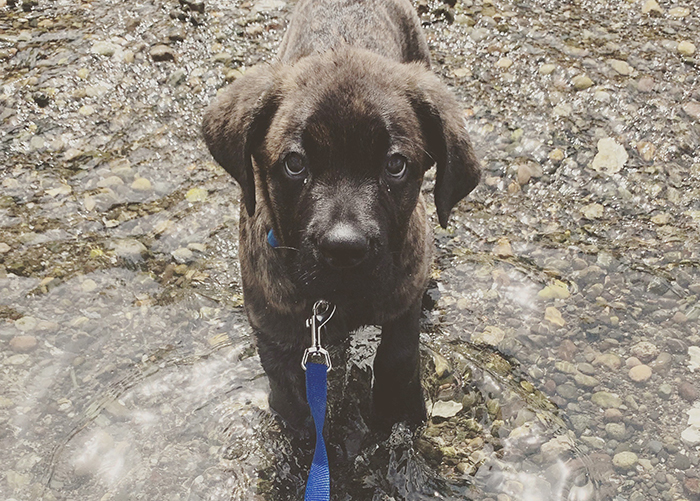
Every day the OSU Veterinary Teaching Hospital witnesses inspiring stories of the human-animal bond in clients who go to great lengths to ensure the good health of their pets. The Kendall family is one such story. In November, Garret, Patricia and their three kids gave their all, financially and emotionally, for a puppy named Griffey that they had only known a few months.
Griffey joined the Kendall household last summer when he was 6 weeks old. He is a Cane Corso big-breed dog, but was the runt of the litter. His joyful, gentle personality quickly captured the hearts of the Kendall family and everyone he met.
When the Kendalls took Griffey to his first checkup, their veterinarian heard a heart murmur, a common condition, generally not too worrisome. Several months later the murmur was worse, so they took Griffey to a cardiologist who found congenital deformities in the puppy’s heart, and referred them to OSU.
Dr. Nicole LeBlanc is a cardiologist at the Lois Bates Acheson Veterinary Teaching Hospital. She and resident Eric Owens evaluated and diagnosed Griffey with four different heart defects including a misplaced aorta, a hole between the lower chambers of the heart, and pulmonic stenosis (the valve between the heart and the lungs is too narrow).
Drs. LeBlanc and Owens knew surgery could help, if not cure, Griffey so they consulted with Drs. Katy Townsend and Milan Milovancev in the soft tissue surgery service at OSU. The two teams decided that the best way to help Griffey was to perform a rare procedure called a Blalock-Taussig-Thomas shunt, where a tube is grafted between the heart and lungs. “The shunt allows the de-oxygenated blood from the aorta to be transported to the pulmonary artery where it is circulated through the lungs and becomes oxygenated,” says Dr. Milovancev. “It is a palliative measure to decrease the severity of his condition.”
By the time the Kendalls met with Dr. Milovancev, Griffey’s condition had worsened and it was having a significant effect on his life: he got tired easily, was slow to get up and go outside, and was even laying down to eat.
Dr. Milovancev explained the challenges for the shunt surgery: he told them that it would not give Griffey a completely normal heart, but it would increase the oxygen in his blood significantly. He told them the prognosis was good for Griffey’s return to normal physical activity, once he had recovered from surgery.
Despite the risk and considerable cost, the Kendalls elected to move forward. “The decision wasn’t easy,” says Garrett Kendall, “but we felt like we owed him a chance at a better heart because he gives us his whole heart every day. He is a full-fledged member of our family and our kids love him dearly.”
Another factor involved in the decision to proceed with the surgery: it had only been performed on a few dogs, and never at OSU, so it was an opportunity for the doctors to refine a life-saving skill. “I told Dr. Milovancev that good or bad, something positive would come from Griffey’s case. Our hope is that in the future they will be able to help other dogs and families.”
Drs. Milovancev and Townsend began a process of extensive planning for the graft surgery. “It was technically challenging and required special equipment,” says Milovancev. Planning up-front also saved time under anesthesia, which was safer for Griffey, and it minimized cost.
Milovancev was also able to save money by getting the manufacturer to donate the ‘tube’ being grafted in Griffey’s heart. “Normally it would cost the client about $1,000,” he says.
The surgery went very well. As Griffey recovered in the Intensive Care Unit, fourth-year student Alexandra Hoff facilitated communication between doctors, ICU, and Griffey’s owners. “I made twice-daily phone calls to update the owners on Griffey’s condition,” she says. “I performed daily physical exams, wrote his treatment sheets (checked by doctors), and most importantly, I made sure he had enough hugs and kisses.”
Being assigned to Griffey’s case was a unique learning experience that Hoff really values. She was responsible for his pre-op and post-op care, and was allowed to scrub-in and observe the surgery. “I was able to feel the blood moving through the shunt after it was placed, and the whole surgery was the coolest procedure I’ve ever been involved with.”
Her close, personal attention to Griffey also gave her an exciting look at his recovery. “It was very cool to see how quickly his cyanosis improved,” she says. “Prior to surgery, his gums were completely purple due to lack of sufficient oxygen; immediately post-op his gums were light pink in color.”
Griffey’s case gave Hoff the opportunity to learn about a segment of cardiology that few students study. “I reviewed the physiology of both left and right shunting cardiac anomalies, and the difference of the impact on the body between the two,” she says. “I read an excellent paper discussing the modified Blalock Taussig shunt; and I learned the important aspects of post-operative care in cardiac cases, and how to manage these cases in both pre- and post-operative periods. Overall it was an incredible experience and both Dr. Milovancev and Dr. Townsend were great!”
The Kendalls also appreciate the doctors and all the people involved in Griffey’s care. “We are so grateful for the work that they did,” says Garrett Kendall. “Our experience at OSU was incredible. Everyone we came into contact with showed a genuine care for Griffey and a love for what they do.”
Although still recovering from his surgery, Griffey’s oxygen levels will continue to improve over time. “He is full of energy,” says Kendall. “He loves to pounce around and play. We are excited to take him to the dog park when he is fully healed.”
